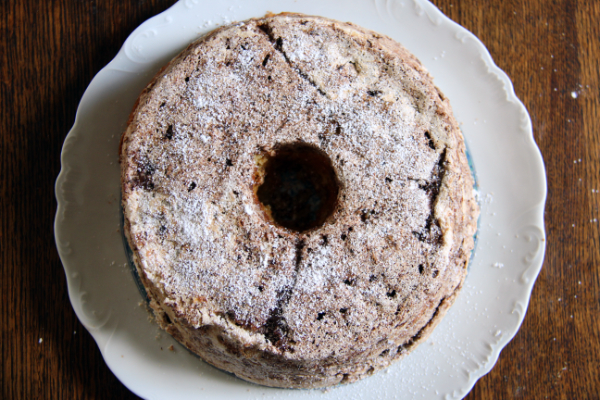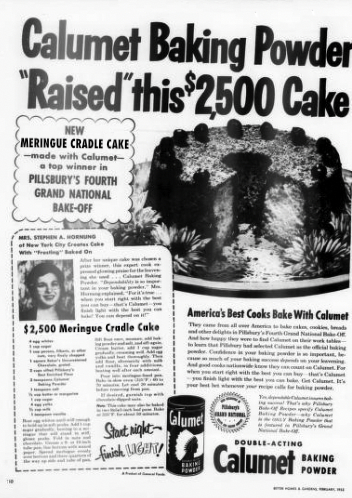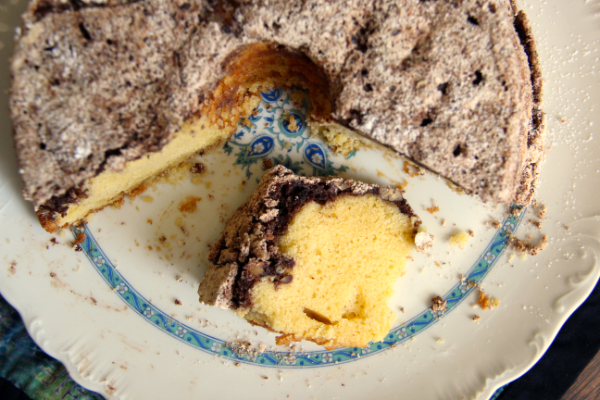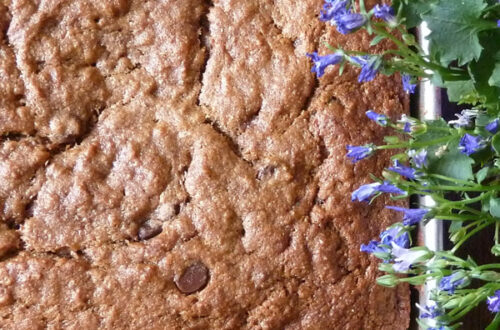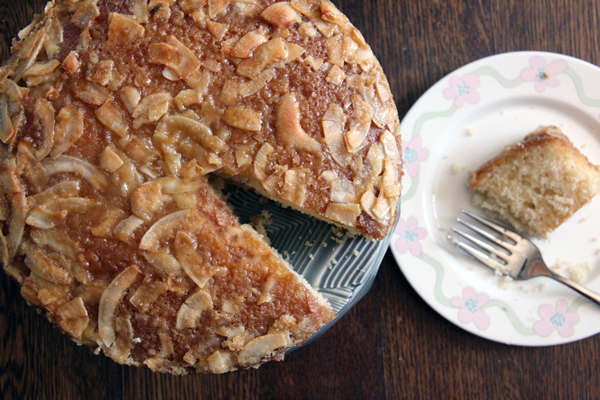Fit for a celebration, Meringue Cradle Cake evokes all the drama of a layered pastry, yet it comes together as if by magic. A crust of chocolate-flecked meringue covers a luxurious golden cake. It looks complicated, but the heavenly contrast of crispy and tender springs from the simple alchemy of separating egg whites and yolks.
Rarely have eggs performed so many tricks in one cake. Yolks pump up the flavor, moisten the crumb, and deepen the color. Whites whip into a brilliant built-in meringue topping. Everything gets used, so there’s no need for egg-white omelets later.
Contrary to what others report, this recipe has nothing to do with the Baby Jesus. We discovered it in From Manna to Mousse (1969) by the Sisterhood of Congregation Beth El, so that should squelch the nativity connection. (See more about this baking bible at One Bowl Apple Cake.)
While Mrs. William Polinsky gets credit for it, she didn’t invent it. Mary Hornung of New York, New York, entered the same cake with the same catchy name in the Pillsbury Bake-Off of 1953, more than 15 years earlier. It won third place and a whopping $2,500. Calumet spread the word with splashy magazine ads featuring Hornung’s headshot and recipe.
“Trish” left this terse comment about Hornung on Cookie Madness’s Meringue Cradle Cake post: “Mary Hornung was my aunt and Godmother. She and my mother were sisters. She was a terrific baker.” That’s it? Trish, honey, if you’re reading this, c’mon, we want stories!
We’d like to believe that Trish’s aunt invented this ingenious cake. After all, the Pillsbury Bake-Off is the NASA of baking innovation. NASA developed memory foam. The Bake-Off gave us Tunnel of Fudge Cake. QED.
But Hornung may have imitated the Blitz Torte, which goes back at least 100 years. It has a similar sponge and meringue, but also a custard filling. If she did borrow it, she axed the filling, a praiseworthy simplification. You can always top it with whipped cream and berries if you feel like it, right?
Hornung also used a tube pan for an elegant presentation. Don’t compromise with stodgy loaf pans. And don’t try a fluted or bundt pan. Those ridges and slopes can’t take the parchment or wax paper lining necessary to release the meringue.
While over the years I’ve submitted several articles to the Boston Globe, this recipe is the only thing they’ve ever printed. I mailed it to “Confidential Chat” (a now-extinct Food Section forum) in response to a plea from a fellow baker desperate for the recipe. I credited From Manna to Mousse and signed with my pen name, “Compulsive Baker.”
But you don’t have to be a compulsive baker to enjoy making, serving, and eating this clever cake. It’s a Pillsbury Bake-Off technological marvel.
Meringue Cradle Cake
(adapted from From Manna to Mousse)
- 4 eggs, separated
- 2 cups sugar
- 1 cup pecans, hazelnuts, or other nuts, finely chopped
- 1 ounce grated, unsweetened chocolate
- 2 cups cake flour (or 1⅞ cups all purpose)
- 3 teaspoons baking powder
- 1 teaspoon salt
- ½ cup butter
- ¾ cup milk
- 2 teaspoons vanilla
- Preheat oven 325°.
- Beat egg whites until they form soft peaks. Add 1 cup of sugar gradually and beat until meringue forms stiff, glossy peaks. Fold in chopped nuts and grated chocolate.
- Grease a 10-inch tube pan and line the bottom with wax or parchment paper. Spread the meringue evenly on the bottom and three-quarters up the sides of the pan.
- Mix flour, baking powder, and salt in a bowl or on wax paper.
- In another bowl, cream butter and 1 cup of sugar. Add egg yolks, one at a time, beating well after each addition.
- Add flour mixture, alternating with milk and vanilla in five additions. Pour on top of meringue shell.
- Bake 60 to 70 minutes. Cool on rack 20 minutes and remove from pan.


